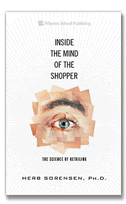Note: Siemon Scamell-Katz has many years of experience studying shoppers in-store. For more than a decade he has specialized in eye-tracking studies that cataloged the detailed fixation by fixation focus of the shopper on the variety of stimuli in their visual space. The insight he has gotten from his visual research very well complements my own understanding of the matter, and this essay of his gives further richness to the 3D Purchase model we discussed some time ago. This present issue provides more depth to the comments Siemon offered in the March 12 issue of The Views: “Changing the Habits of a Lifetime.”
Herb Sorensen
------------------------------------------------------------------------------------------------------------------------------
In our industry, it is vital to understand the mechanics of shopper choice. The fundamental driver is that some purchases are more important to consumers and shoppers than others.
Decisions that are really important, like choice of car, are made consciously. Such decisions often sustain perceived status and involve purchases of high financial value or visibility. While advertising plays an awareness role, consumers look to peers or trusted editorial for endorsement.
Secondary decisions involve much less research. The items involved such as breakfast cereals or coffee, are functionally important but have relatively little impact on status. These are often commodities that are purchased on a regular basis and therefore ‘choice’ is habituated.
Finally there are items that are not very important to shoppers. For these, they rely on retailers to pre-select a range of simple options. They generally use very simple tools such as price to confirm their choice.
Individual category roles depend on the frequency with which they are shopped and shoppers' level of involvement, but every category can, and should, be assigned an appropriate role in-store with varying emphasis on visibility and theatre.
In addition, the majority of shopper decisions are not based on the decision tree model (although the traditional approaches to brand management, category management, merchandising and marketing presuppose that they are).
Shopper decisions are instead influenced by a mixture of reasoning, emotion - and memory. Explicit memories are the result of high attention (to advertising, word-of-mouth or editorial, for example). Implicit memories result not from attention but from subconscious associations.
Implicit memories probably account for about 85% of in-store ‘decisions’. This is why colourshape is the key to recognising packs in-store, for example.
The typical shopper has extremely low involvement with the majority of categories: purchases from all but a few categories are habituated. The majority of shoppers always buy from the same repertoire of products.
Habituated shoppers may be loyal because they are committed or because they are unconcerned. However, floating shoppers may like several brands; be unhappy with a particular brand; or not care which brand they buy.
Brands should seek to understand the behaviour ‘scripts’ of both habituated and floating shoppers. And by understanding the relative significance of implicit and explicit memories, it is at last possible to connect the consumer and the shopper.
This makes it possible to embed implicit - as well as explicit - cues for shoppers in advertising and create strategies for shopper marketing, promotions, pricing and merchandising for both groups of shoppers.
Brand communications should incorporate high attention elements to invoke analytical memories, as well as broad associations (for example of colour and shape) to stimulate in-store recall of implicit memories.


